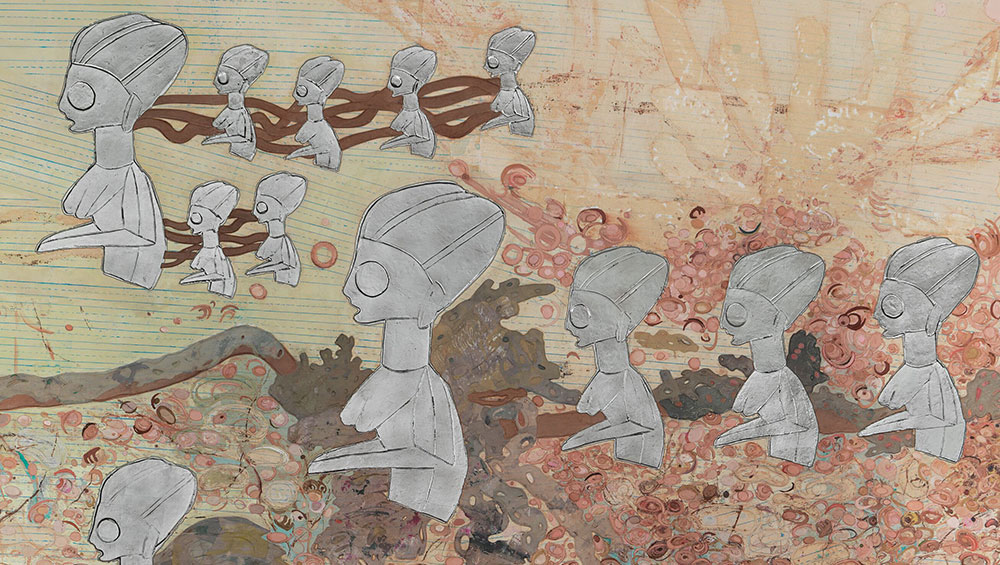
Ellen Gallagher. Ecstatic Draught of Fishes, 2020 (detail). Oil, palladium leaf and paper on canvas, 248 x 202 cm (97 5/8 x 79 1/2 in). Photo: Tony Nathan. © Ellen Gallagher. Courtesy the artist and Hauser & Wirth.
Hauser & Wirth, London
21 May – 31 July 2021
by DAVID TRIGG
As a rule, commercial galleries do not pipe music into their exhibitions. If they did, Ellen Gallagher’s sparkling new show at Hauser & Wirth, London, would no doubt be accompanied by a playlist of tracks from the Detroit electro-techno outfit Drexciya. The underground duo’s 1990s productions grew from a complex Afrofuturist mythology that involved a highly developed underwater species descended from the children of pregnant West African slaves who were thrown overboard during the trans-Atlantic deportation. Gallagher has drawn inspiration from the Drexciya myth for years, combining it with historical references and autobiography to evolve her own multilayered origin myth rooted in the voyage of the Middle Passage. Her new large-scale paintings and watercolours further expand these ideas, transporting you to a submarine realm populated by curious creatures that frolic amid clouds of shimmering amoebas and sea plants. These are mysterious, uncharted corners of the ocean where natural history, imperialism and colonialism collide.
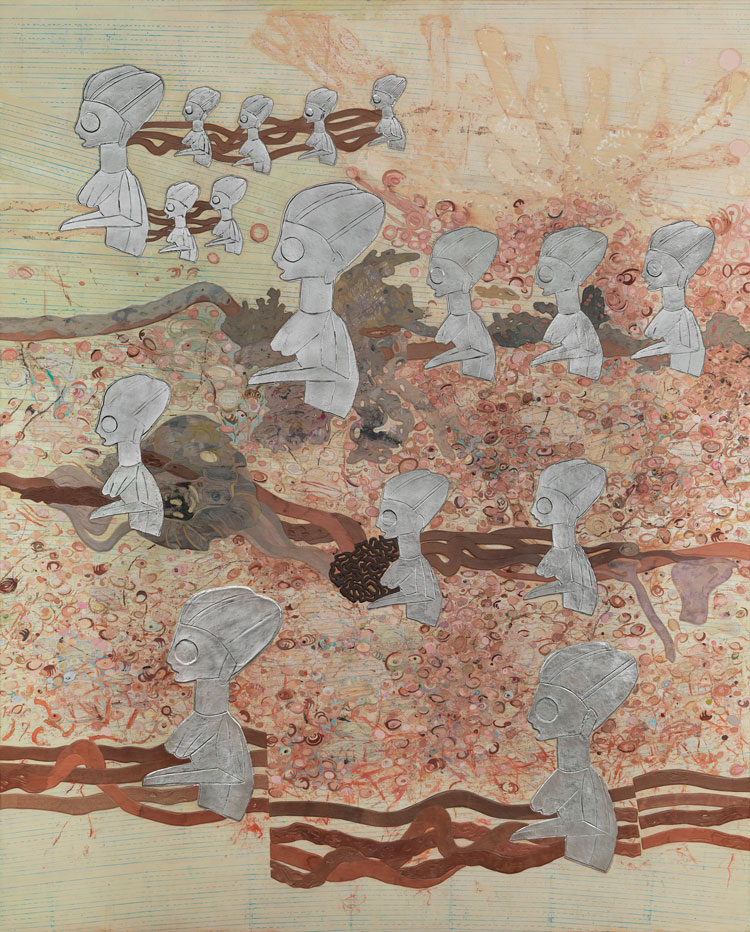
Ellen Gallagher. Ecstatic Draught of Fishes, 2020. Oil, palladium leaf and paper on canvas, 248 x 202 cm (97 5/8 x 79 1/2 in). Photo: Tony Nathan. © Ellen Gallagher. Courtesy the artist and Hauser & Wirth.
Gallagher began her Ecstatic Draught of Fishes series in 2019 and, to date, has completed three paintings (all titled Ecstatic Draught of Fishes). Two of them greet you when you enter the elegantly lit gallery. Pasted sheets of handwriting paper provide striated grounds on to which layers of paint and collaged palladium-leaf figures have been applied. The glistening, alien-looking creatures that populate these works are based on ancient African Fang carvings of the type that inspired many 20th-century European avant garde artists. In one work (dated 2020), several appear to be emerging from swarms of aquatic biomorphs, while others are carried along on trails of seaweed, caught up in ocean currents or even on the warpath. In the neighbouring work, completed this year, three lustrous figures float like discarded relics amid the weeds; the mood here is one of abandonment. Getting close to these paintings reveals a complex, otherworldly topography formed from an array of abstract marks and incisions, thickly painted patterns and layers of collaged paper. Part science fiction, part science fact, their fantastical surfaces entice you to explore.
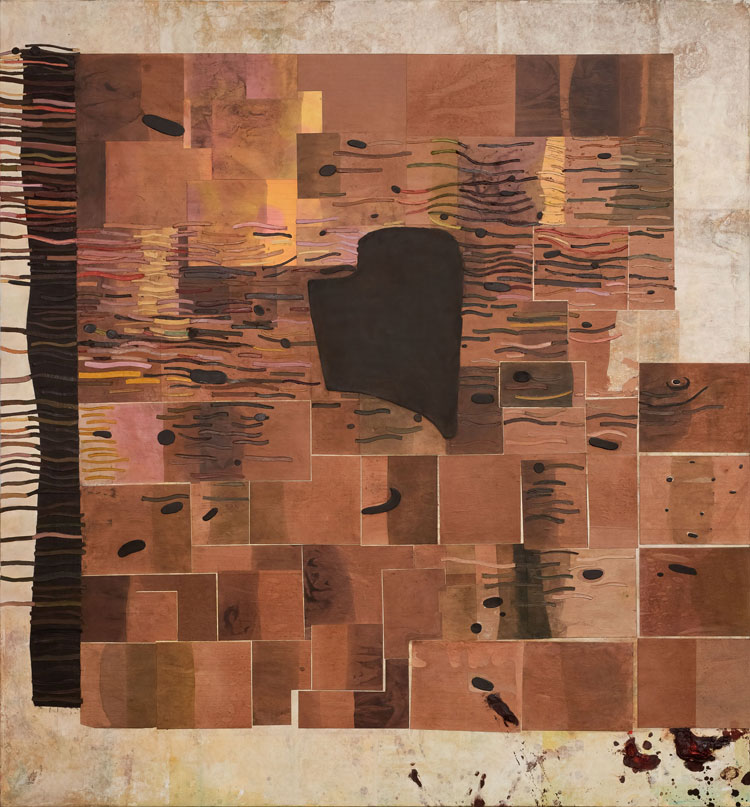
Ellen Gallagher. Paradise Shift, 2020. Mixed media on canvas, 202 x 188 cm (79 1/2 x 74 in). Photo: Tony Nathan. © Ellen Gallagher. Courtesy the artist and Hauser & Wirth.
Appearing slightly out of place with its dark, earthy palette is Paradise Shift (2020). Gallagher’s signature handwriting paper again provides the ground on which a patchwork of earthen hues is overlaid with undulating patches of thick red, pink, yellow and brown lines that evoke flowing movement. We are perhaps surveying the ocean floor, though the palette suggests a more arid terrain. An ominous dark shape hovers near the work’s centre, adding to the general air of fragmentation and instability. As with the other works, this painting is a world in itself, one that can only be properly appreciated up close. Indeed, reproductions do no justice to Gallagher’s delicate and sumptuously detailed works, which, when viewed in person, reveal her to be a masterful and subtle colourist.
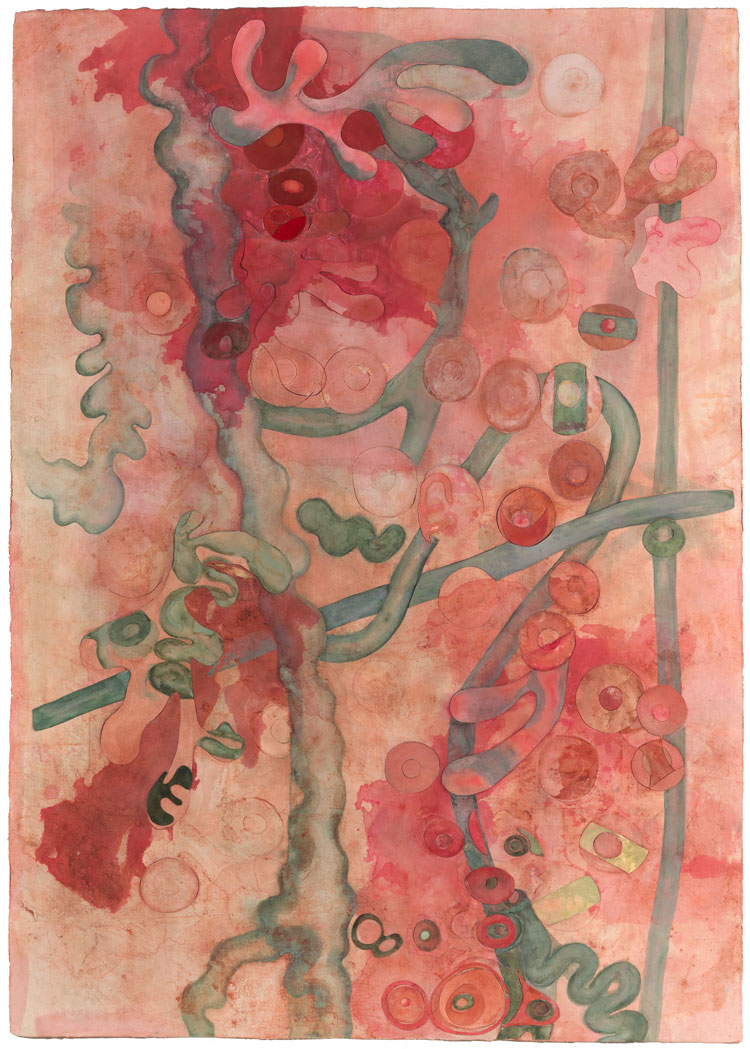
Ellen Gallagher. Watery Ecstatic, 2021. Watercolour, varnish, and cut paper on paper, 198 x 140 cm (78 x 55 1/8 in). Photo: Tony Nathan. © Ellen Gallagher. Courtesy the artist and Hauser & Wirth.
While Gallagher’s works are very much open to interpretation, they have developed from several clearly defined points of reference. Alongside the aforementioned Drexciyan myth is Peter Paul Rubens’ The Miraculous Draught of Fishes (1618-19), which is alluded to in the show’s title. The painting depicts an episode from the Gospel of Luke in which Christ invites a group of fishermen to go back to sea after an unsuccessful night; reluctantly they agree, only to find their nets are suddenly overflowing with a miraculous haul of fish. Two other art historical references are Théodore Géricault’s The Raft of the Medusa (1819), depicting the ghastly aftermath of a shipwreck, and JMW Turner’s The Slave Ship (1840), which illustrates the horror of sick slaves being thrown overboard. Formally, you would be hard pressed to identify these influences anywhere across Gallagher’s intricate surfaces, yet hers is a process that is materially and conceptually entwined, allowing for multiple layers of appreciation.
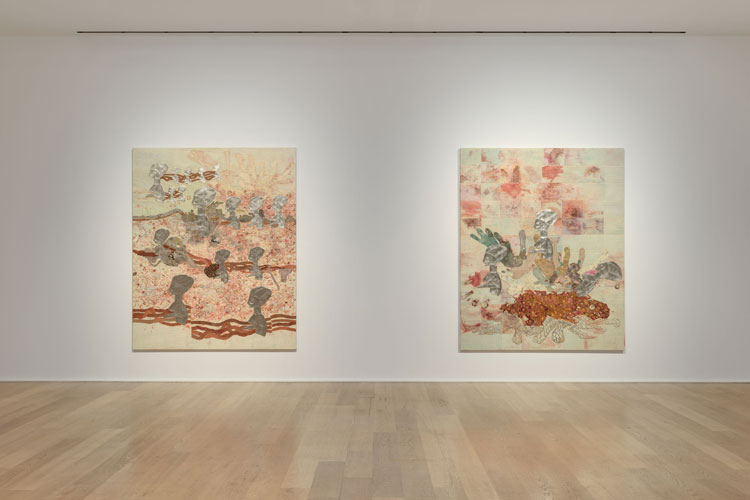
Ellen Gallagher: Ecstatic Draught of Fishes, installation view, Hauser & Wirth, London, 2021. Photo: Tony Nathan. © Ellen Gallagher. Courtesy the artist and Hauser & Wirth.
An important influence on her new watercolours – the most recent of the Watery Ecstatic series begun in 2001 – is the Dutch painter Albert Eckhout (c1610-65), one of the first European artists to document scenes from the New World, primarily Brazil. Gallagher’s paintings draw on Eckhout’s contribution to the Dutch colonial governor’s project to catalogue the local flora, fauna and people of the new territory – the prosperous sugarcane-producing region in the northeast of Brazil. Her own works (both titled Watery Ecstatic and dated 2021) document the imaginary marine life of her growing cosmology. In one painting, a blushed octopus floats above a tangle of seaweed, while another tentacled creature skulks below. The first stains the thick, undulated watercolour paper, whereas the second is formed from layers of painted, collaged paper. The adjacent painting features an array of organic forms, twisting and meandering like microbes under a microscope. Painted with classic pigments including Burgundy ochre, Venetian red, Bohemian green earth and blueish-green earth from Cyprus, Gallagher lets her colours mingle, soak and bleed into the paper. Indeed, these painted and collaged images revel in their materiality, so much so that their opulent formal qualities overshadow any sociopolitical commentary.
Gallagher’s paintings are visually compelling and conceptually expansive. With just five works on show and such a rich tapestry of references, this show leaves you yearning for further opportunities to be submerged into her watery world.